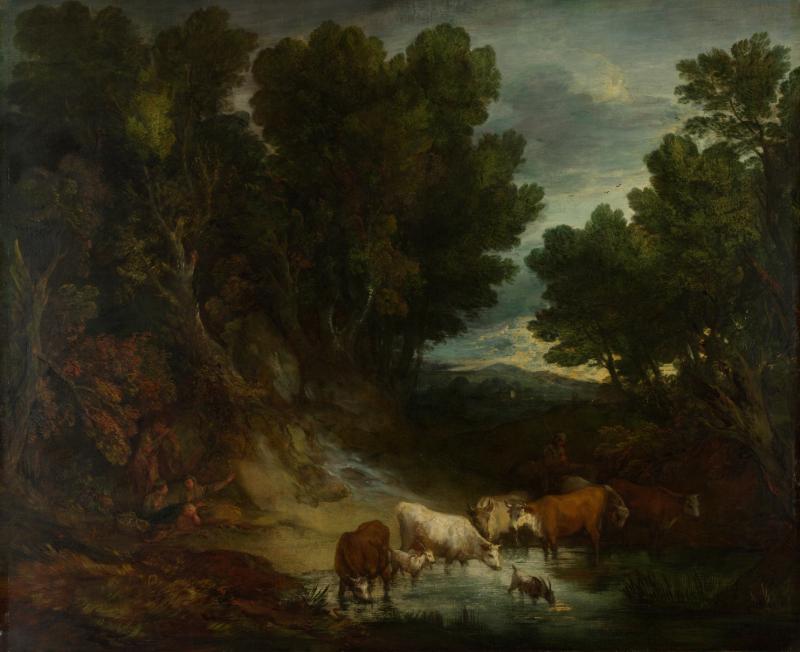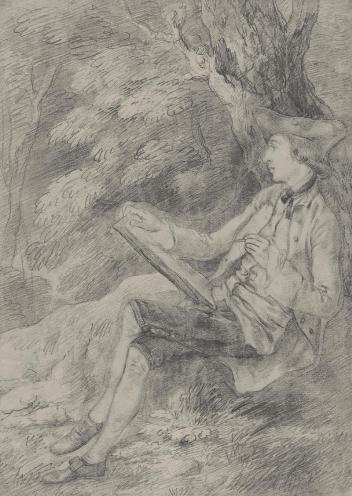Gainsborough's Landscapes: Themes and Variations, Holburne Museum | reviews, news & interviews
Gainsborough's Landscapes: Themes and Variations, Holburne Museum
Gainsborough's Landscapes: Themes and Variations, Holburne Museum
Portraitist leaves humans out of it in a series of idealised homages to the natural world

Dogs, horses, cows, sheep, goats and pigs are the creatures that, however minuscule in stature, take pride of place in the fascinating exhibition of Thomas Gainsborough’s imaginary landscapes at the Holburne in Bath, an ideal complement to the nine major Gainsborough portraits in their British picture gallery.
Surprisingly for one of the most prominent portrait-painters in all of British art, Gainsborough's animals, lovingly portrayed, their body language based on acute observation, dominate their human counterparts in these landscapes, who are more or less rural stereotypes.
The half-dozen landscape paintings, ranging in date from the 1740s to the 1780s, are augmented and complemented by prints and drawings in pencil and coloured chalks. The overwhelming impression is one of serenity and tranquillity, drama subdued and beauty evoked. Here are huge and graceful trees, cloud-filled milky skies, and clumps of humans, travelling peasants who are all dependent on their livestock for their livelihood. The fanciful painted landscapes drip with rural charm, punctuated by workers whose ruddy good cheer belies the inescapable hardness of life. The animals seem truly carefree, relaxed as they go simply about their business: pigs rooting for food, dogs herding the sheep, or enticing their young owners to play, occasionally even bouncing with exuberance.
 Suffolk-born Gainsborough (1727-1788) was fortunate to appear as the art market slowly became systematised; he made his living as a portrait painter; a founder member of the Royal Academy, he spent more than 20 years in Bath, attracting a rich clientele, and finally moved to London. He faced the economic and inescapable necessity of painting portraits with wry good humour (echoed two centuries later by John Singer Sargent). Like many an artist before and since, he complained about the difficulties of his human clients, which is perhaps why he loved both keeping and painting animals. (Pictured above: Self-portrait.)
Suffolk-born Gainsborough (1727-1788) was fortunate to appear as the art market slowly became systematised; he made his living as a portrait painter; a founder member of the Royal Academy, he spent more than 20 years in Bath, attracting a rich clientele, and finally moved to London. He faced the economic and inescapable necessity of painting portraits with wry good humour (echoed two centuries later by John Singer Sargent). Like many an artist before and since, he complained about the difficulties of his human clients, which is perhaps why he loved both keeping and painting animals. (Pictured above: Self-portrait.)
It is the perpetual liveliness of animal spirits that lifts the landscapes beyond the static. Many of Gainsborough’s drawings do stem from observation, a way of practising and keeping his hand in, but his realised landscape paintings instead often referred to 17th-century landscape genres of ideal and idealised rural idylls, by such masters as Rubens. We are also told by his contemporaries that in his studio he made model landscapes out of materials such as cork to play around with compositional effects. Passionately musical, he was vividly aware of themes and variations, of musical forms which enrich through repetition.
The titles are generalised, as no landscape painting can be related to a specific view. In the National Gallery’s The Watering Place (main image) cows plus goats are gratefully hock-deep in the pond, illuminated by a patch of sunlight overshadowed by vast and graceful trees: Gainsborough’s trees in his paintings (not in his sharply observed drawings) are partly platonic fantasies, ideals of foliage like vast greenish ink spatters against the sky.
In River Landscape with a View of a Distant Village much is owed to Dutch landscape - winding roads echoed by a winding river, and the dense foliage recalling Ruisdael - but the earth spirits of several dogs, two sheep and a donkey accompanying their human masters are typical Gainsborough. In Wooded Landscape, Two Carthorses, the sturdy horses, ears bent back to listen for threat, are certainly friends: one cools his hind legs in a stream while casually resting his head on the rump of his companion. (In 1763, the prescription that cured Gainsborough of the "Nervous Fever" that he suffered in Bath was riding out every day.) In Landscape with Travellers Returning from Market, the dogs and packhorses are of equal stature to the peasants who accompany them, and perhaps portrayed with even more empathy.
Click on the images to enlarge
[bg|/ART/Gainsborough]
- Mountainous Landscape with Shepherds and Sheep: "Romantic Landscape", 1780-85 (© Royal Academy of Arts, London; photographer Prudence Cummings Associates)
- River Landscape with a View of a Distant Village, c 1750 (National Galleries of Scotland)
In Wooded Landscape with Figure and Cattle, the eye is captured by the stockman, and his faithful dog just behind him, as both contemplate their charges resting. Constable found Gainsborough’s landscapes invariably brought a tear to the eye, and there is indeed something affecting and touching about these studies in serene quietude, an acceptance of cyclical nature supporting its human and animal transients.
The rustic scenes he claimed as his first love may be a little too artificially contrived in execution for our taste, even if an argument is convincingly made for their modernity (curator Susan Sloman's catalogue vividly explorates his art and the context in which it was practised, culminating in the embryonic movement towards Romanticism). But it is all deeply enjoyable. Gainsborough does not reproduce well, so there is all the more reason to see these paintings, with their surprisingly free brushwork, in the flesh, not to mention the musculature of the many drawings also on view. And the exhibition is a perfect partner to the Holburne’s holding of bepowdered aristocrats and gentry of society, allowing an unusually full insight into his art.
- Gainsborough’s Landscapes: Themes and Variations at the Holburne Museum in Bath until 22 January, then Compton Verney 11 February-10 June 2012.
Explore topics
Share this article
more Visual arts
 Stephen review - a breathtakingly good first feature by a multi-media artist
Melanie Manchot's debut is strikingly intelligent and compelling
Stephen review - a breathtakingly good first feature by a multi-media artist
Melanie Manchot's debut is strikingly intelligent and compelling
 Fantastic Machine review - photography's story from one camera to 45 billion
Love it or hate it, the photographic image has ensnared us all
Fantastic Machine review - photography's story from one camera to 45 billion
Love it or hate it, the photographic image has ensnared us all
 Yinka Shonibare: Suspended States, Serpentine Gallery review - pure delight
Weighty subject matter treated with the lightest of touch
Yinka Shonibare: Suspended States, Serpentine Gallery review - pure delight
Weighty subject matter treated with the lightest of touch
 Jane Harris: Ellipse, Frac Nouvelle-Aquitaine MÉCA, Bordeaux review - ovals to the fore
Persistence and conviction in the works of the late English painter
Jane Harris: Ellipse, Frac Nouvelle-Aquitaine MÉCA, Bordeaux review - ovals to the fore
Persistence and conviction in the works of the late English painter
 Sargent and Fashion, Tate Britain review - portraiture as a performance
London’s elite posing dressed up to the nines
Sargent and Fashion, Tate Britain review - portraiture as a performance
London’s elite posing dressed up to the nines
 Zineb Sedira: Dreams Have No Titles, Whitechapel Gallery review - a disorientating mix of fact and fiction
An exhibition that begs the question 'What and where is home?'
Zineb Sedira: Dreams Have No Titles, Whitechapel Gallery review - a disorientating mix of fact and fiction
An exhibition that begs the question 'What and where is home?'
 Yoko Ono: Music of the Mind, Tate Modern review - a fitting celebration of the early years
Acknowledgement as a major avant garde artist comes at 90
Yoko Ono: Music of the Mind, Tate Modern review - a fitting celebration of the early years
Acknowledgement as a major avant garde artist comes at 90
 Unravel: The Power and Politics of Textiles in Art, Barbican review - the fabric of dissent
An ambitious exploration of a neglected medium
Unravel: The Power and Politics of Textiles in Art, Barbican review - the fabric of dissent
An ambitious exploration of a neglected medium
 When Forms Come Alive, Hayward Gallery review - how to reduce good art to family fun
Seriously good sculptures presented as little more than playthings or jokes
When Forms Come Alive, Hayward Gallery review - how to reduce good art to family fun
Seriously good sculptures presented as little more than playthings or jokes
 Entangled Pasts 1768-now, Royal Academy review - an institution exploring its racist past
After a long, slow journey from invisibility to agency, black people finally get a look in
Entangled Pasts 1768-now, Royal Academy review - an institution exploring its racist past
After a long, slow journey from invisibility to agency, black people finally get a look in
 Barbara Kruger, Serpentine Gallery review - clever, funny and chilling installations
Exploring the lies, deceptions and hyperbole used to cajole, bully and manipulate us
Barbara Kruger, Serpentine Gallery review - clever, funny and chilling installations
Exploring the lies, deceptions and hyperbole used to cajole, bully and manipulate us
 Richard Dorment: Warhol After Warhol review - beyond criticism
A venerable art critic reflects on the darkest hearts of our aesthetic market
Richard Dorment: Warhol After Warhol review - beyond criticism
A venerable art critic reflects on the darkest hearts of our aesthetic market

Add comment